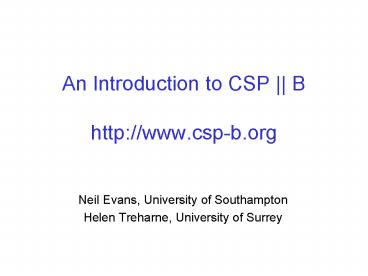An Introduction to CSP B http:www'cspb'org - PowerPoint PPT Presentation
1 / 20
Title:
An Introduction to CSP B http:www'cspb'org
Description:
Will the type of system to be described influence our choice of modelling language? ... CSP and Object-Z (Smith/Derrick 1997) CSP || B (Schneider/Treharne 1999, 2000) ... – PowerPoint PPT presentation
Number of Views:79
Avg rating:3.0/5.0
Title: An Introduction to CSP B http:www'cspb'org
1
An Introduction to CSP Bhttp//www.csp-b.org
- Neil Evans, University of Southampton
- Helen Treharne, University of Surrey
2
Motivation for Research
What aspects of a complex system can we describe?
Will the type of system to be described influence
our choice of modelling language?
Will one modelling approach be sufficient for our
needs, or should we consider integrating
different ones? How do we integrate different
approaches?
3
Overview of Tutorial
- What is CSP B ?
- Introducing single components
- Proving consistency
- Introducing multiple components
- Proving consistency revisited
- Describing an overall CSP B specification
- What can we prove about CSP B specifications?
- Case Study
- Conclusions and future plans
4
What is CSB B ?
5
Event vs State
- CSP for analysing control aspects
- Hoare 1985
- Multos (secure smart card operating system) 2000
- FDR 1989
- B for analysing operations on state
- Abrial 1991
- Line 14 Paris Metro 1998
- BToolkit 1993
6
What makes CSPkB novel?
- CSP and Object-Z (Smith/Derrick 1997)
- CSP B (Schneider/Treharne 1999, 2000)
- Retains original semantics of CSP and B
- Morgans CSP semantics of action systems provides
a formal link between the two worlds (1990) - Clear separation of views
- Enables use of existing tools
- CSP2B (Butler 2000)
- Circus Z CSP (Woodcock/Cavalcanti 2002)
7
Example B machine
- A B machine is the main construct used in B
specifications - It is object-like because it encapsulates state
and operations - Its interface are the operations it provides
- State consist of a set of variables that are
constrained by the machines invariant - Operations can accept input, change the state,
and query the state.
8
B Operations
- Partial or fragile operations have preconditions
- A precondition is an assumption that the caller
of the operation needs to makes sure that it
holds - Cannot guarantee an operations behaviour if
called outside its precondition - Example floor gt 0 in dec
- Total or robust operations
- Always safe to call these operations
- Example isZero
- All our operations are non-blocking, can always
be called but may not always be safe to do so
9
Sequences of B operations
- Consider the Lift machine in its initial state
- is a valid sequence
- is not a valid sequence
- is not a valid sequence
- is a valid sequence
- We characterise all sequences of operations as
traces - We characterise invalid sequences of operations
as divergences
10
How to control B machines?
- CSP used to control flow of operation calls
- Define a controlled component
- Parallel combination of a controller and a B
machine - Justified because both CSP and B have process
semantics - Use CSP events to match B operations
calls
P
M
11
Example Lift Component
up.3
up
down
ground
- External channels accept input or communications
- B operations are called to set the state of the
lift appropriately
LiftCtrl
inc
dec
inc.3
isZero
Lift
3
0
12
Example Lift Component
13
Controller language
- The CSP controller language for driving a B
machine is sequential one thing follows another.
It includes (among others) - Input and output on an external channel
- Input and output on a machine channel
- choice
- conditional expression
- parameterised recursive call
14
Ensuring Consistency of a Single Component
- We require that B operations are always called
within their preconditions so that we have a
divergence-free component - We start from the point of having a consistent
machine, i.e. one which preserves its invariant
15
Proof of Consistency
- Each process body is translated into an
equivalent sequence of B operations - A control loop invariant (CLI) is constructed so
that - It is established after initialisation
- Each (translated) process body maintains the
invariant
16
Example with no parameters
- Two coins are input
- User can choose either a chocolate or biscuit -
their B operations have the same behaviour - Is this a consistent component?
17
Proving Consistency
- At the end of each pass through the VM loop
and is an appropriate - We use the following translation rules
- We prove using wp semantics
18
Proof of Consistency (revisited)
- When we have mutually recursive processes and
input and output communication we need more
complex proof conditions - The environment binding allows us to track
values
19
Importance of Initialisation Condition
- Consider the process
- where the B operation reset is defined as
- and the initialisation
- CLI is
- The CLI proof boils down to
- However the initialisation condition is not met
20
Summary
- CSPB Development Steps covered so far
- Develop the B components and verify state
properties - Develop each component pair
- Verify divergence freedom of each pair































